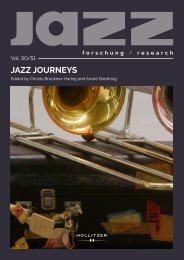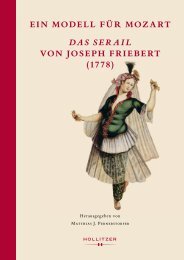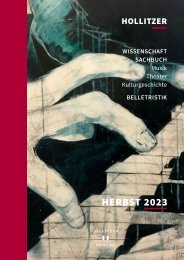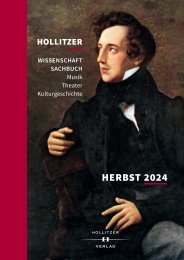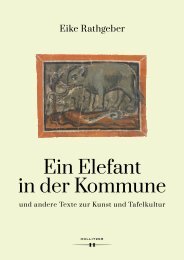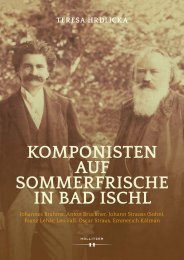You also want an ePaper? Increase the reach of your titles
YUMPU automatically turns print PDFs into web optimized ePapers that Google loves.
feel the need to thematise Leyla [Saz] Hanımefendi? Was it because they respected<br />
her music? Was it toward the dissemination of her literary endeavours? Or is it<br />
simply due to the ‘respect’ she gained from her memoirs on the imperial harem?<br />
That is to say, would we have known, or even heard of Leyla [Saz] Hanımefendi if<br />
she had not been raised together with the sultanas in the imperial palace?<br />
The secondary sources state that Leyla [Saz] Hanımefendi was able to enter<br />
the imperial harem at the age of just four years as the lady-in-waiting for Sultan<br />
Abdülmecid I’s daughter, Münire Sultan (1844–1862), due to her father’s position<br />
as the doctor of Sultan Abdülmecid I, and was raised in the palace with the children<br />
of the dynasty. Her maintained connection with the members of the Ottoman<br />
dynasty even after she had left the palace is apparent both in her memoirs as<br />
well as in the accounts of her great-grandchildren. 10<br />
Some music scholars mention in their writings that Leyla [Saz] Hanımefendi’s<br />
works are seldom performed because they require superior skills and virtuosity 11 , and<br />
state that performers of such quality could rarely be found, while others claim<br />
that – just as in her poetry and prose – she has a clean, sincere, and intimate tone in<br />
her compositions. 12 Is it possible to analyse the values and parameters on which<br />
these judgements are based? Such questions steered the direction of this research,<br />
and motivated me to investigate Leyla [Saz] Hanımefendi and the inconsistencies<br />
in her portrayal.<br />
During my research in the Güran family’s archive, I happened upon a news<br />
article entitled “Bestecilikte Yeni bir Leyla Hanım [A New Leyla Hanım in the Field<br />
of Composing]” 13 which led me to the idea of connecting the two composers and<br />
taking a ‘continuity’ approach. Although Nazife Aral-Güran (1921–1993) was<br />
born before the proclamation of the Republic, she was raised in the period of<br />
construction of a nation-state, and so became the second stop after Leyla [Saz]<br />
Hanımefendi in my historical journey. This selection provided me with the op-<br />
10 Nezih H. Neyzi, Kızıltoprak Stories. (İstanbul: Peva Publications, 1999). Leylâ Saz, The Imperial<br />
Harem of the Sultans: Daily Life at the Çırağan Palace During The nineteenth Century, ed. Landon Thomas<br />
(İstanbul: Hil Yayın, 2001). Ali H. Neyzi, Meyzi ve Neyzi. (İstanbul: Cem Yayınevi, 2005).<br />
Ali H. Neyzi. Hüseyin Paşa Çıkmazı No. 4 [Hüseyin Paşa Dead-End Street Number 4] (İstanbul:<br />
Cem Yayınevi, 2005). Nezih H. Neyzi, Osmanlılıktan Cumhuriyet’e Kızıltoprak Anıları (İstanbul:<br />
Türkiye İş Bankası Kültür Yayınları, 2016).<br />
11 Baki Süha Ediboğlu, Ünlü Türk Bestekarları [Famous Turkish <strong>Composers</strong>]. (İstanbul: Ak Yayınevi,<br />
1962), 139–143. Saz, Leyla. Harem’in İçyüzü [Harem Behind the Scenes], ed. Sadi Borak (İstanbul:<br />
Milliyet, 1974), 19. Reinhard and Reinhard, Türkiye’nin Müziği, 43. Ahmet Şahin Ak, Türk Musikisi<br />
Tarihi. (Ankara: Akçağ, 2014), 233.<br />
12 Ruşen Ferit Kam, “Bestekar-Şair Leyla Hanım,” Radyo Mecmuası. No. 55 (1946), 8. Mehmet Nazmi<br />
Özalp, “Leyla Saz,” Türk Musikisi Tarihi [The History of Turkish Music], Vol. 2 (Ankara: Müzik<br />
Dairesi Başkanlığı, 2000), 24. Öztuna, Akademik Klasik Türk San’at, 266.<br />
13 Hikmet Münir Ebcioğlu, “Bestecilikte Yeni bir Leyla Hanım [A New Leyla Hanım in Composing]”,<br />
Hayat, No. 101 ( 17 December 1973), 23.<br />
24



